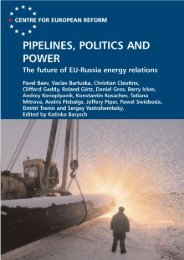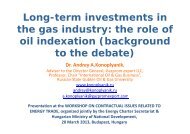ecause of the enlargement of the EU from EU-15 to EU-25/27, when the great part ofthe infrastructure in the former COMECON states of CEE, created by Gazprom and/or itspredecessors on the basis of the same principles, which were used by many Europeancompanies within the EU, turned out to be situated since 2004/2007 within the bordersof the new enlarged EU (Figure 1) and has thus come under the EU regulation. Andthen, after the unfortunate Russian-Ukrainian events of January 2006 and January2009, Gazprom became the part of the "target audience" for further liberalizationmeasures at the single EU gas market (aimed, inter alia, to diminish dependence onGazprom and Russian gas), being formed at that point in time (Third EU <strong>Energy</strong>Package).I think that it is exactly the growing competition at the EU gas market, which willeffectively force Gazprom to adapt its contractual and pricing policies to the newrealities of the European gas market, causing it to be more competitive in the processfor the race of expanding its presence within the narrowing competitive niche of theRussian gas in Europe. I think that administrative intimidations, like the most recent(04.09.2012) or the previous (27.09.2011) raids, cannot really influence the situation.The measures taken by the CEC are probably more based on the desire of the DGCOMP to choose a manner of action similar to corresponding American events, whichtook place a century ago. In 1890 the U.S. Congress adopted the antitrust "ShermanAct", aimed at the de-monopolization of the US oil market. As a result in 1911,Rockefeller's "Standard <strong>Oil</strong> of New Jersey" was forced to be split to 34 smallerindependent companies, though not horizontally, in a way that unbundling("segmentation” of VICs) is happening now at the European market, but vertically. Itwas much easier afterwards for the US government to deal with each of them ratherthan previously with one strong super-giant since “economy of scale” effect ("effect ofconcentration") applies not only to the economy, but to the politics as well ("divide andrule" principle).“Perspectives in <strong>Energy</strong>”, 2006, volume 10, N 1, p. 1‐24; Russian <strong>Gas</strong> to Europe: From Long‐Term Contracts, On‐Border Trade, Destination Clauses and Major Role of Transit to …? – “Journal of <strong>Energy</strong> and Natural Resources<strong>Law</strong>”, 2005, vol.23, N 3, p. 282‐307, etc.15
2.2 Result of decisions of historic pastWhen I just became a first-year student at the <strong>Energy</strong> Faculty of the MoscowInstitute for Engineering and Economics in September 1970, almost at the first lectureof the “Introductory Course to <strong>Energy</strong> Economics” one of the greatest Soviet energyeconomists, prominent specialist in system studies in the energy field, academician LevA. Melentyev, reading the named lectures to us, accented the words, which Iremember, and repeat, in turn, nowadays to my own students: "In the field of energywe live in the era of investment decisions, adopted 15 years ago". However, the highlevel of capital intensity of investment projects in energy and their long lifecycles(especially in upstream in development of giant fields) has increased significantly. Sonow we live in the era of investment decisions, taken not 15 years, but even somedecades ago. This note can be fully applied to Gazprom and to its operations in Europe,since in todays’ gas market we face a situation in CEE as the result of investmentdecisions taken a few decades ago. Europe has inherited the current configuration of itsgas infrastructure and the mode of its operations in gas since the historical past of the1960s.The current monopoly position of Gazprom on the current CEE market, where thecountries of Central and Eastern Europe are already members of the EU, is the result ofinvestment decisions for infrastructure development carried out during another politicalera and in different economic conditions. It was the then divided Europe during thetime of the Cold War, when the CEE countries were members of the CMEA and formeda part of the world centrally planned system, when this infrastructure was createdbased on realities of that political era. That political era has now gone, but its materialresults (configuration of the capital intensive immobile infrastructure) are still in placepredetermining the configuration of gas flows and their underlying economics.I think that, first of all, it is not Gazprom who is responsible for the lack ofdevelopment of the gas transportation infrastructure in the CEE, though it is Gazpromwho is nowadays blamed for this. The infrastructure was created primarily in "pre-16
- Page 1 and 2: Oil, Gas & Energy Law Intelligencew
- Page 4 and 5: The CEC declared that the matter wi
- Page 6 and 7: publicly significant functions and
- Page 8 and 9: 1.3 Decree 1825On September 11 th 2
- Page 10 and 11: state agency for Gazprom within the
- Page 12 and 13: oversupplied (with competitive supp
- Page 14 and 15: From my point of view, there are ma
- Page 18 and 19: Gazprom" times by the Soviet state-
- Page 20 and 21: 3 Claim 1. But could Gazprom separa
- Page 22 and 23: 3.1 Destination clausesAnother logi
- Page 24 and 25: eselling of gas destined for the mo
- Page 26 and 27: From my view, most of the blame tow
- Page 28 and 29: This way, the main goal for the EC'
- Page 30 and 31: development of, for example, the "N
- Page 32 and 33: investment climate for infrastructu
- Page 34 and 35: producer at early stages of market
- Page 36 and 37: Figure 4. Evolution of oil & gas ma
- Page 38 and 39: Producers/exporters/hedgers (Indust
- Page 40 and 41: Moreover, evaluating the entire Eur
- Page 42 and 43: manipulations of the gas price by g
- Page 44 and 45: state might expect by this short-te
- Page 46 and 47: So it is very important to bear in
- Page 48 and 49: In my view, such a soft adaptation
- Page 50 and 51: competitive supplies in this area,
- Page 52 and 53: arbitrary panel outcomes; settlemen
- Page 54 and 55: need to develop more costly fields
- Page 56 and 57: (Figure 11. LTGEC in Europe: indexa
- Page 58 and 59: the Russian gas and large taxpayers
- Page 60 and 61: many Europeans, but, and this is mo
- Page 62: RIA “Novosti” - Russian Informa












